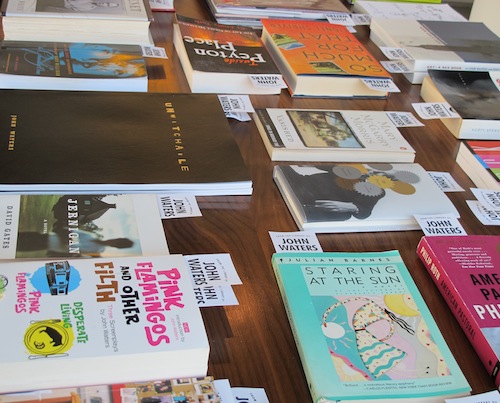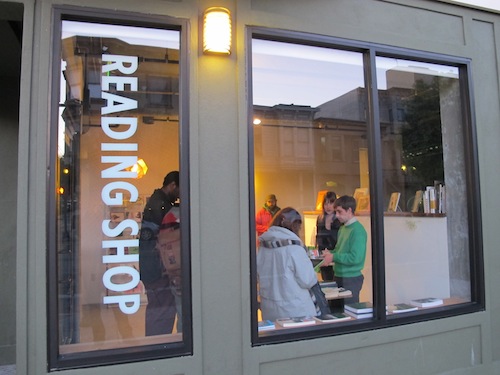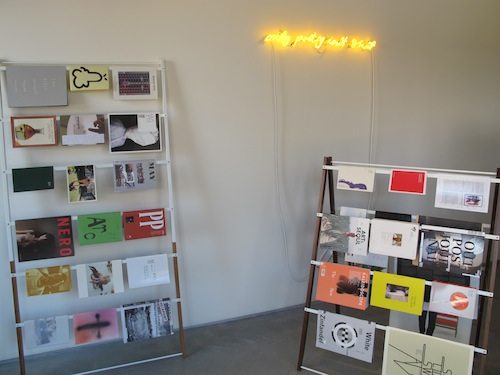One of my favorite art spaces in San Francisco is the Kadist Art Foundation, a non-profit organization based in both Paris and San Francisco whose mission is to “… participate[s] in the development of society through contemporary art …”. Kadist SF offers a diverse range of programming, including their ever-popular Wednesday evening program that brings in writers, curators and artists to speak or present work, a gallery, a magazine residency program, and a Reading Shop.
Kadist’s dedication to critical discourse is what drew me to feature them here. Each year, Kadist SF hosts one or two magazine residencies. The primary editorial team from the magazine in residence is invited to SF for one-month, with the goal to produce an issue based on their research conducted in the city. To date, Kadist SF has hosted May Revue (Paris), Nero (Rome), and Fillip (Vancouver).
Last week, I had the pleasure of speaking to Kadist SF Program Manager, Devon Bella, about the Reading Shop, which is open every Saturday and during their Wednesday evening programs. Devon’s thoughtful curation of the space and available publications creates the perfect atmosphere for both casual browsing and research.
Devon’s resources for finding publications include:
Motto Distribution
do you read me?!
Contemporary Culture Index
NY Art Book Fair
Kelly Huang: Kadist SF used to host a Saturday Reading Room, where art-related books and magazines were available for people to enjoy. How did the idea for the Reading Room evolve into the new Reading Shop? What is different?
Devon Bella: For those of your readers who might not have had a chance to visit last year, every Saturday we opened Kadist to the public as a Reading Room featuring over 100 copies of international art magazines, that printed both in English and their native language, and lacking regular distribution in the US and North America. The premise of the shop is largely the same, a visitor may come and browse for the afternoon, but now everything is for sale, meaning they can take it with them. The collection of publications was always meant to invoke the nature of a library, that is, an emphasis on the experience of browsing and discovering things that were formerly unknown. The only difference now is that the Reading Shop will counterbalance the conditions previously required to make those discoveries, which was a Saturday afternoon dedicated to a single magazine or piece of text. The evolution from library to shop was also in many ways a reconsideration of the context of display, in terms of Kadist’s overall programming. With a large audience building around the weekly Wednesday series, we wanted to not only capture their attention then, but adjust our ability for both programs to happen simultaneously, thus the Reading Shop is now open late on Wednesdays, and has a semi-permanent space in our office.
KH: Right now, you are featuring books from John Waters’ library in your Reading Shop. The books are available to browse through and to purchase. Did John choose which books to feature? If so, did you provide him with any guidelines?
DB: In that shift from the Reading Room to the Reading Shop, we decided in addition to featuring magazines, we would highlight an independent art publisher alongside a curated selection of books from someone’s individual library. I have been following John Waters for a long time, as he is well known among literary and art circles as a bibliophile. I was aware of other “John Waters reading lists,” and in the process of further research into John’s history, I found that fiction has played a critical role launching his career and influencing his creative practice, in both his filmmaking, writing and photography. When I approached him about the Reading Shop, I asked him to provide titles from both his personal library and bibliography. Because he is also an active writer and has produced several exhibition catalogues, I asked for the names of books from his own bibliography. I did not give him specific guidelines in terms of content, but rather described the space and the arc of the Kadist programs.
KH: To step back for a moment, why has Kadist SF chosen to put a spotlight on books and magazines?
DB: We understand that a large part of art discourse occurs via printed publications and there is a need to increase the availability of such resources to San Francisco art audiences. When Joseph del Pesco, Kadist SF director, and I first crossed paths, it was was collaborating on this very subject, working together on Art Publishing Now (APN) at Southern Exposure, a weekend event, a fair and public forum around art publishing in the Bay Area. There are many local artists, critical thinkers and writers working in the field of publishing and there was a desire to mirror that activity as it is taking place internationally in other cities from Seoul to Rome, to Buenos Aires.
KH: When you look at the way artists are working now, many have a very rigorous practice that is grounded in literature and other types of text, so being able to come here and have a resource room is so valuable and reflects that shift in practice.
DB: Yes, and once we started doing research, just over a year ago, we discovered countless numbers of serial publications, and through that process were ever so compelled to make these available for Bay Area artists in particular. Part of the larger mission of Kadist is bringing global perspectives in conversation with local inclinations and activity, and showcasing art magazines is one way for us to achieve that goal.








